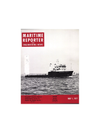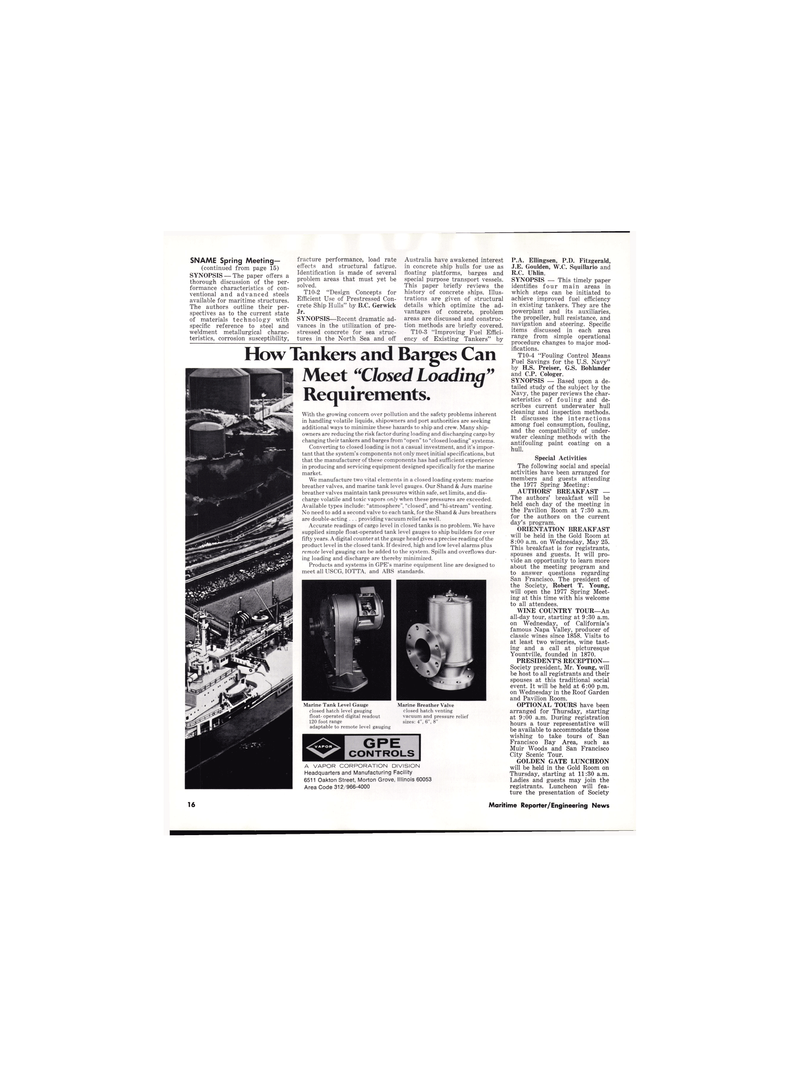
Page 14: of Maritime Reporter Magazine (May 1977)
Read this page in Pdf, Flash or Html5 edition of May 1977 Maritime Reporter Magazine
SNAME Spring Meeting— (continued from page 15)
SYNOPSIS — The paper offers a thorough discussion of the per- formance characteristics of con- ventional and advanced steels available for maritime structures.
The authors outline their per- spectives as to the current state of materials technology with specific reference to steel and weldment metallurgical charac- teristics, corrosion susceptibility, fracture performance, load rate effects and structural fatigue.
Identification is made of several problem areas that must yet be solved.
T10-2 "Design Concepts for
Efficient Use of Prestressed Con- crete Ship Hulls" by B.C. Gerwick
Jr.
SYNOPSIS—Recent dramatic ad- vances in the utilization of pre- stressed concrete for sea struc- tures in the North Sea and off
Meet
Headquarters and Manufacturing F 6511 Oakton Street, Morton Grove,
Area Code 312/966-4000
Australia have awakened interest in concrete ship hulls for use as floating platforms, barges and special purpose transport vessels.
This paper briefly reviews the history of concrete ships. Illus- trations are given of structural details which optimize the ad- vantages of concrete, problem areas are discussed and construc- tion methods are briefly covered.
T10-3 "Improving Fuel Effici- ency of Existing Tankers" by iarges Can
J T I* >» is 60053
P.A. Ellingsen, P.D. Fitzgerald,
J.E. Goulden, W.C. Squillario and
R.C. Uhlin.
SYNOPSIS — This timely paper identifies four main areas in which steps can be initiated to achieve improved fuel efficiency in existing tankers. They are the powerplant and its auxiliaries, the propeller, hull resistance, and navigation and steering. Specific items discussed in each area range from simple operational procedure changes to major mod- ifications.
T10-4 "Fouling Control Means
Fuel Savings for the U.S. Navy" by H.S. Preiser, G.S. Bohlander and C.P. Cologer.
SYNOPSIS — Based upon a de- tailed study of the subject by the
Navy, the paper reviews the char- acteristics of fouling and de- scribes current underwater hull cleaning and inspection methods.
It discusses the interactions among fuel consumption, fouling, and the compatibility of under- water cleaning methods with the antifouling paint coating on a hull.
Special Activities
The following social and special activities have been arranged for members and guests attending the 1977 Spring Meeting:
AUTHORS' BREAKFAST —
The authors' breakfast will be held each day of the meeting in the Pavilion Room at 7:30 a.m. for the authors on the current day's program.
ORIENTATION BREAKFAST will be held in the Gold Room at 8:00 a.m. on Wednesday, May 25.
This breakfast is for registrants, spouses and guests. It will pro- vide an opportunity to learn more about the meeting program and to answer questions regarding
San Francisco. The president of the Society, Robert T. Young, will open the 1977 Spring Meet- ing at this time with his welcome to all attendees.
WINE COUNTRY TOUR—An all-day tour, starting at 9:30 a.m. on Wednesday, of California's famous Napa Valley, producer of classic wines since 1858. Visits to at least two wineries, wine tast- ing and a call at picturesque
Yountville, founded in 1870.
PRESIDENT'S RECEPTION—
Society president, Mr. Young, will be host to all registrants and their spouses at this traditional social event. It will be held at 6:00 p.m. on Wednesday in the Roof Garden and Pavilion Room.
OPTIONAL TOURS have been arranged for Thursday, starting at 9:00 a.m. During registration hours a tour representative will be available to accommodate those wishing to take tours of San
Francisco Bay Area, such as
Muir Woods and San Francisco
City Scenic Tour.
GOLDEN GATE LUNCHEON will be held in the Gold Room on
Thursday, starting at 11:30 a.m.
Ladies and guests may join the registrants. Luncheon will fea- ture the presentation of Society
HowT
With the growing concern over pollution and the safety problems inherent in handling volatile liquids, shipowners and port authorities are seeking additional ways to minimize these hazards to ship and crew. Many ship- owners are reducing the risk factor during loading and discharging cargo by changing their tankers and barges from "open" to "closed loading" systems.
Converting to closed loading is not a casual investment, and it's impor- tant that the system's components not only meet initial specifications, but that the manufacturer of these components has had sufficient experience in producing and servicing equipment designed specifically for the marine market.
We manufacture two vital elements in a closed loading system: marine breather valves, and marine tank level gauges. Our Shand & Jurs marine breather valves maintain tank pressures within safe, set limits, and dis- charge volatile and toxic vapors only when these pressures are exceeded.
Available types include: "atmosphere", "closed", and "hi-stream" venting.
No need to add a second valve to each tank, for the Shand & Jurs breathers are double-acting . . . providing vacuum relief as well.
Accurate readings of cargo level in closed tanks is no problem. We have supplied simple float-operated tank level gauges to ship builders for over fifty years. A digital counter at the gauge head gives a precise reading of the product level in the closed tank. If desired, high and low level alarms plus remote level gauging can be added to the system. Spills and overflows dur- ing loading and discharge are thereby minimized.
Products and systems in GPE's marine equipment line are designed to meet all USCG, IOTTA, and ABS standards. mm
J
Marine Tank Level Gauge closed hatch level gauging float- operated digital readout 120 foot range adaptable to remote level gauging
Marine Breather Valve closed hatch venting vacuum and pressure relief sizes: 4", 6", 8"
A VAPOR CORPORATION DIVISION 16 Maritime Reporter/Engineering News

 13
13

 15
15
